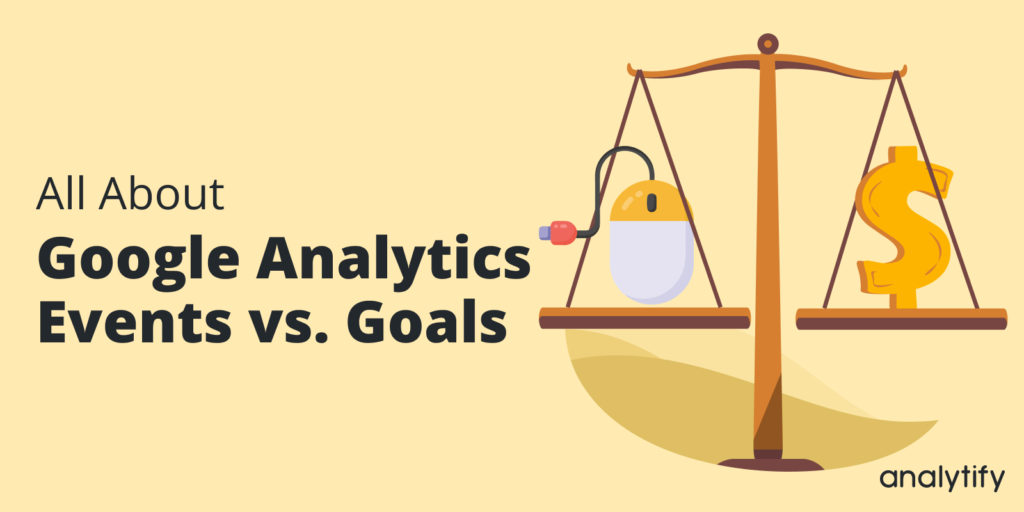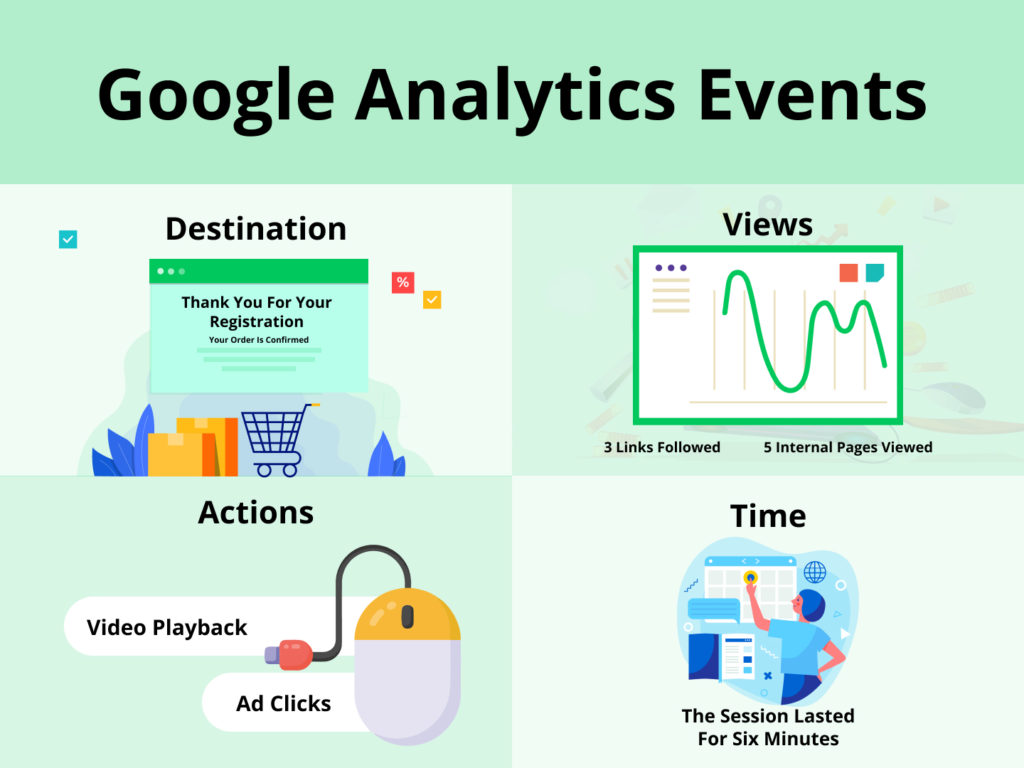
All About Google Analytics Events vs Goals (Simple Guide)
Are you confused about Google Analytics events vs goals?
You are not alone. Even experienced users aren’t sure which one to use in a particular scenario. Google Analytics is a fantastic data tracking and reporting platform. However, you need to understand the use of goals and events to tag user interactions for further analysis properly.
In this article, we’ll go through the details of events and goals and help you understand the ideas behind Google Analytics events vs goals.
Table of Content
- What are Google Analytics Events?
- What are Google Analytics Goals?
- How Goals and Events are Related
- Significant Differences Between Google Analytics Events and Goals
- Analytify Simplifies Goals and Events
- Conclusion
- Frequently Ask Questions
What are Google Analytics Events?
Events track user interactions with the elements on the website pages. For example, with events, you can measure the instances of users responding to the CTAs and media on the pages. A simple example of Google Analytics Events is a user clicking the Submit button on a registration form.
Events are used to track user actions that happen after a user lands on a page. For instance, events are used to track page scrolls and video views. Because of this definition, you can use Google Analytics to track the following four types of events.
Keyboard-generated Events
These events are generated when a user interacts with the page through the keyboard. A good example is a user filling in an opt-in form.
Mouse-generated Events
These events include clicks and taps to cover all devices and record user interactions, such as clicks and scrolls.
Form Events
These events cover all form-based interactions. For instance, you can track the number of times the users submitted a form.
Frame Events
These events track the events that occur when a frame or page loads. For instance, you can track the number of times a user reloads a page.
Another way of seeing Google Analytics events is in the context of page views. Some events generate page views while others don’t. This is an important classification because pageviews are a fundamental user behavior metric that every website owner tracks.
For instance, when a user clicks an internal link, a pageview is generated and recorded. On the other hand, clicking an external link doesn’t result in a pageview because the user moves away from your website.

You can see Events related reports in the Behavior tab of the Reports.
Examples of Google Analytics Events
- Clicking on a link
- Playing a video
- Downloading a File
- Scrolling a page
- Adding a product to the cart
What are Google Analytics Goals?
Goals are used to track the successful completion of a user action, also known as a conversion. These actions are related to the KPI you set for your website. For instance, you can have a goal of tracking how many registration forms are submitted. Now, every time a user submits the form, Google Analytics records the conversion and increases the goal counter.
Goals are essential to measuring the performance of your marketing campaigns because Google Analytics measures the website actions of the users in response to your marketing activities. You can even assign a monetary value to a goal so that Google Analytics can report the dollar value of the conversions along with the conversion count.
Goals can be divided into the following four types.
Destination-based Goals
These goals are related to what happens after a specific page or screen loads after a conversion. For instance, Google Analytics records a conversion when a thank-you page loads up in response to a user filling out a form.
Duration-based Goals
These goals record conversions that occur when a session lasts for (or exceeds) a specific time limit. For instance, Google Analytics records a conversion when a user session continues for 6 minutes or more.
View-based Goals
These goals record conversions that occur when a user views a specific number of website pages or app screens. For instance, you can set a goal that records a conversion when a user views 3 website pages. Note that these goals can be set independent of the duration-based goals, and you can combine the reports to see both sets of goal completion.
Action-based Goals
These goals are tied to specific user events that trigger conversions. This set of goals records the successful completion of a predetermined user action, such as clicking the share button or downloading a file. When a user completes an action, Google Analytics records it as a conversation for the specific goal.

You can see Goals-related reports in the Conversions tab of the Reports.
Examples of Google Analytics Goals
- Newsletter sign-ups
- Leads generated from contract forms
- eBook downloads
- Users registering for phone calls
- Website user spends a certain amount of time on site
How Goals and Events are Related
In the Google Analytics Events vs Goals debate, many users forget that these two entities have a lot in common. The end goal of using these in Google Analytics is to track user activity and connect it with the business objectives. The idea is to understand what marketing activities drive the users to take the desired actions.
Events and goals are not isolated from each other. In fact, these two are two different ways of understanding how the users interact with your website. A simple way of understanding the common theme between the entities is this: Events track user actions that contribute toward Goal completion.
Significant Differences Between Google Analytics Events and Goals
Google Analytics Events and Goals have a couple of differences that you need to know when building your Google Analytics strategy.
| Google Analytics Events | Google Analytics Goals |
| An Event can occur independently without needing an endpoint or a destination. | A Goal is always tied to a specific destination, such as a page or duration. |
| Events provide a single piece of data. | Goals tracking can record multiple pieces of data, including the actual conversion and the increase in the goal count. |
| Events can be recorded multiple times per session. For instance, all instances of user scrolls in a session will be registered and recorded. | A Goal is recorded only once a session. For instance, a user might submit a form using two different email addresses in a session. This will be counted as a single conversion. |
| An Event is not based on a Goal. So, for instance, clicks don’t really tie down to a goal. | A Goal can be based on an event. File downloads for a business pitch deck are an excellent example of a goal based on an event. |
Analytify Simplifies Goals and Events
In the heat of debating Google Analytics Events vs Goals, many people forget the issue that troubles many Google Analytics users. It is tedious to constantly sign in and check the stats for goals and events.
Analytify resolves this critical issue by bringing all vital information to the WordPress Dashboard.
The Analytify Dashboard has dedicated tabs for events and goals data. For instance, the Acquisition tab presents a summary of goal completion. The goal tracking capabilities ensure that you get a quick view of essential metrics in the dashboard.
Similarly, Analytify simplifies event tracking and can show data for popular events such as clicks on links and file downloads.
Conclusion: Google Analytics Events vs Goals
We hope you now have a clear idea of Events and Goals in Google Analytics. The debate of Google Analytics events vs goals is an ongoing topic. You now know enough to make informed decisions about your Google Analytics strategy and start measuring the numbers that move the needle forward for your business.
Frequently Ask Questions
What Goals should I set if my focus is on content promotion?
While each organization has unique requirements, we recommend focusing on time on page (should be 5 minutes or more), scroll depth (ideally 70% or more), and video watch time of around 70%.
In Google Analytics Goals vs Events, what should I pick?
Both entities are important because they track different aspects of user behavior. It would help if you came up with goals and events that present a complete picture of your website performance and start tracking them in Google Analytics.
Is there a way to view events and goals data without logging into Google Analytics?
Yes, Google Analytics dashboard plugins such as Analytify fetch data from the platform and display it right in your WordPress dashboard. This way, you get the essential data without leaving your website.
That’s all! You can also check out What is Direct Traffic in Google Analytics (Easy Guide) and How to Track Facebook Ads in Google Analytics 4.
Not using Analytify yet? What are you waiting for?




